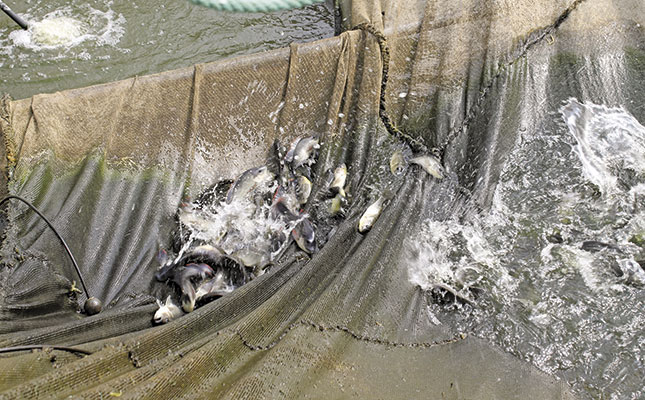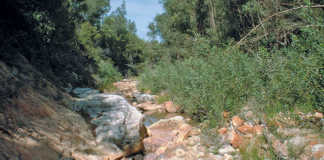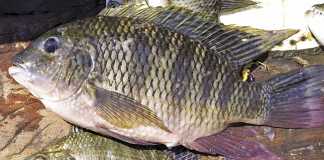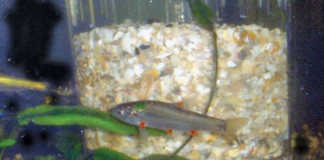
Interest in tilapia farming is growing, but few entrepreneurs are getting off the ground. David Fincham, from Dicla Eco Tilapia projects, says that although the company gets thousands of enquiries about tilapia farming, callers are quickly put off by the high capital costs involved in setting up a well designed system. “Tilapia farming is capital intensive. There is no cheap way to do it. It’s not a case of simply digging a hole, filling it with fish, feeding them chicken manure and harvesting kilograms of fish.”
READ:Ultrasonic sound used in drip irrigation line cleaning
He says that the biggest misconception about tilapia is that you can feed them chicken manure. “While they will eat it, the growth rate will be too slow to make it profitable.” Dicla has developed a tilapia production system with a small footprint of 800m² and a high cyclic production. With a total cost of around R800 000, fully installed, farmers can expect to make R60 000 gross profit per month, excluding loan repayments.
“This system is like having built the first chicken house. It will need to be developed, refined and perfected. But any system will work as long as basic principles and parameters are met.”

David Fincham
Building a fish farm
The Dicla tilapia system entails excavating a 51m x 12m hole, 1, 5m deep, which is lined and split into three production channels by building access and bio-walls. The trenches are lined with a geo textile and then a plastic liner. This adds insulation and prevents excessive heat loss. Drain pipes run at the bottom of the ponds and water is pumped from the ponds through the bio walls, where the nitrogenous bacteria collected on the gravel media can clean the water. The system is a complete closed re-circulating system.
Nine nets are placed in the fish ponds to hold the fish. The fingerlings start off in net one and are then shifted to a bigger net every three weeks as they grow. As soon as fish from net one are shifted, this net is restocked with more fingerlings. By week 27, the fish are about 350g and ready for harvest. With this system, there is a constant supply as fish are harvested every one to three weeks depending on how the stock is managed.
Fish that escape through handling and that are bred in the system are left in the ponds as they help to eat the algae that form on the sides of the ponds and nets. As these breed, their fingerlings are put back into the system. David says that because tilapia is a warm water fish, the primary consideration is water temperature. “The water temperature needs to be around 27°C to 29°C, but this does not occur naturally year-round in any part of the country as the average summer temperatures for SA are, at best, 23°C. The temperature makes a big difference in the growth of the fish. At 23°C, the fish will only weigh 200g after six months, but can weigh as much as 440g at 27°C.”
Since heating water is costly, this system relies on solar heat directly captured in the greenhouse, as well as system design. A standard greenhouse is erected over the fish ponds. The surface area of the greenhouse acts as a solar heat absorber, ensuring that the temperature inside the greenhouse is high enough to keep the water warm. It also ensures that the day and night water temperature differs by no more than 2°C and 3°C.
Another important factor in the success of tilapia farming is the water filter. This is crucial to ensure healthy fish. David says that due to the high stocking density of the fish, a swimming pool filter is unsuitable. “A mechanical filter is needed for solid waste while the bio filter removes nutrient and fish waste such as ammonia and nitrates. “The filter design of the system must cope with the feed and biological loads to ensure that the water is kept clean and free of the build-up of toxins which will cause stress, slow growth, disease and even mortalities,” says David.
He adds that a system can never have too much filtration. “We also add ozone via an ozone generator to boost the dissolved oxygen we require for the high stocking densities in the system. It also acts as a bacterial agent which kills bacteria in the water.” The farm requires two full-time workers to run the system seven days a week and an additional four to six people during harvest.
When full, the whole system holds 21t of fish and production costs are around R16/ kg to R18/kg of fish. Current legislation stipulates that an environmental impact assessment (EIA) is needed if production is more than 20t of tilapia per year. But David says that this could change as the industry develops. “We are working with government to ensure that policy and legislation is being developed to benefit the industry.”

The Dicla tilapia farming system makes use of nine nets in which to keep the fish.
Stocking
Ponds down the sides of the greenhouse that are 3m x 2m x 0,5m are used to breed fingerlings so that the farm is not solely reliant on an outside supply of fingerlings. The ponds are stocked at a rate of five males to 30 females. Short pieces of drainpipe are left in the pond for the fish to hide from aggressive males once they are carrying eggs and fry. Every 28 days, the breeding ponds are drained, the fry collected and the ponds are refilled with fresh water and stocked with new breeding stock.
David notes that breeding one’s own supply of fingerlings is not ideal as it can lead to inbreeding, but is necessary until the industry is strong enough to supply a constant amount of quality and fairly priced fingerlings. “The tilapia genetic stock available at present needs further improving. With proper genetic selection, production can be improved by 20%, as has been done in other parts of the world using the Oreochromis niloticus species for the development of the genetically improved farmed tilapia (GIFT) gene lines.”
Fish are stocked at 45kg/ m3 of water. They are fed tilapia pellets which include ingredients such as soya, maize, fish meal, bone meal, vitamins and minerals, ensuring a well-balanced, high performance diet for the commercial growth of tilapia. “Maggots can also be used as they are a good source of protein, but more research is needed to see what the long-term effect will be on fish feeding solely off maggots. This will prove vital for improving production in rural communities where commercial feed is not available and is too expensive,” says David.
Fish are hand-fed throughout the day, averaging seven feeding times, to ensure the optimal use of feed. The average feed conversion ratio used is 1,3kg feed to produce 1kg of fish. David says that the mortality rate on the farm is less than 2%. “Anything more than that and there is a problem that needs to be addressed urgently.
Markets
The biggest constraint to tilapia farming at present is the lack of a market for the fish.Most farmers sell the fish off their farms, to farm stalls and fish traders. Fish traders in local communities are the biggest market for now as the industry’s low production cannot fulfil the needs of the formal markets. Farmers can sell tilapia for around R35/ kg to R40/kg of fish.
“At this stage there isn’t much of a market for the fish. Pick n Pay alone needs to be secured of about 340t per month before they will stock tilapia. A market won’t be created for the fish if the volume is not sufficient, but farmers won’t increase the numbers unless the market is there. Some supermarkets do stock tilapia but because an abundance of quality stock is not always available, supply is limited.”
There are few full-time tilapia farmers in SA. Farmers can only consider themselves commercial if they are producing a minimum of 100t per year. Most farmers are currently averaging 10t per year to 20t per year. “If this industry is to succeed, then farms need to be run as businesses, not sideline operations as is currently the case.” The industry has formed a producers’ association which will promote, develop and drive the industry to reach its true potential.
Forcing a higher male ratio
Tilapia eggs are neither male nor female and only develop their sex later. Since male tilapia grow faster than females, some
farmers add testosterone to the feed for small fish to ensure a high percentage of males. Although the practice attracted criticism from environmentalists fearing testosterone residues in fish, David says that by the time the fish are harvested, the hormones would have left the body.

A fish grader is used to ensure only good quality fingerlings are put into the system. Fish are put into the grader and the levers adjusted so that the smaller fish fall through.
He notes that the males and females only differ by between 10% and 15% in size. “If you are growing fish for fillets then it will make a difference but if you are selling whole fish then the difference is negligible.“In a high density system the competition for food is anyway high enough to ensure that females are as eager to eat as males.” Dicla does not actively promote the practice because of resistance from consumers. “Although resistance is still small, we don’t want to cause unnecessary resistance in a product that could take years to rectify,” says David.
Contact David Fincham on 082 048 3382.
This article was originally published on 08 March 2013 in Farmer’s Weekly.













